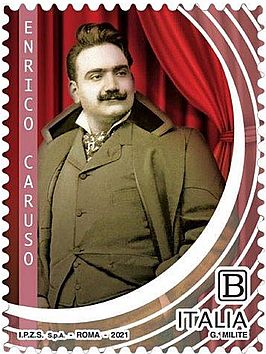
Italien 25.10.2021
The Italian opera singer Enrico Caruso was born in Naples on 25 February 1873. He died in his hometown on 2 August 1921 at the age of only 48. February 2023 marks the 150th anniversary of his birth.
Caruso, whose voice was already noticed as a boy in the church choir, made his opera debut at the age of 19. His breakthrough came five years later with the role of Federico in the world premiere of Francesco Cilea’s opera “L’Arlesiana” at the Teatro Lirico in Milan. Later he also took part in the world premieres of Umberto Giordano’s opera “Fedora”
Caruso, whose voice was already noticed as a boy in the church choir, made his opera debut at the age of 19. His breakthrough came five years later with the role of Federico in the world premiere of Francesco Cilea’s opera “L’Arlesiana” at the Teatro Lirico in Milan. Later he also took part in the world premieres of Umberto Giordano’s opera “Fedora”
In addition to his stage presence, Enrico Caruso’s work for the Victor Talking Machine Company was one of the decisive factors in the triumph of the record. Caruso recorded a total of 498 titles. These include opera arias as well as many popular songs such as Eduardo Di Capua’s song “O sole mio”, which he helped to make it world famous. The aria “Vesti la giubba” from the opera “Pagliacci”, recorded on 1 February 1904, was the recording industry’s first million-seller.
The video shows a shellac record with Enrico Caruso’s very first recording “E Lucevan Le Stelle” from Puccini’s opera “Tosca”. The recording was made on 11 April 1902 in Milan for G&T Records, a subsidiary of RCA Victor. At this first recording session, 10 titles were recorded, of which only one master each was made. Because of the unexpected success, the masters wore out very quickly, so that new masters had to be created from the records that were made. The record in the video is based on such a repressing, which was produced by G&T Records for the European market in the late 1940s.